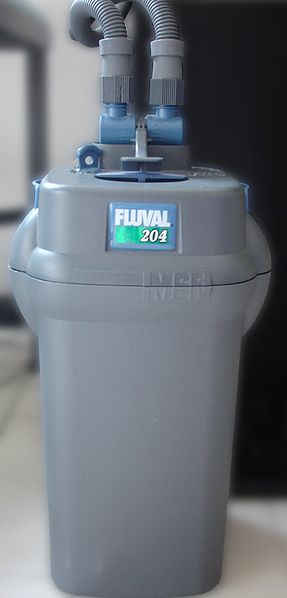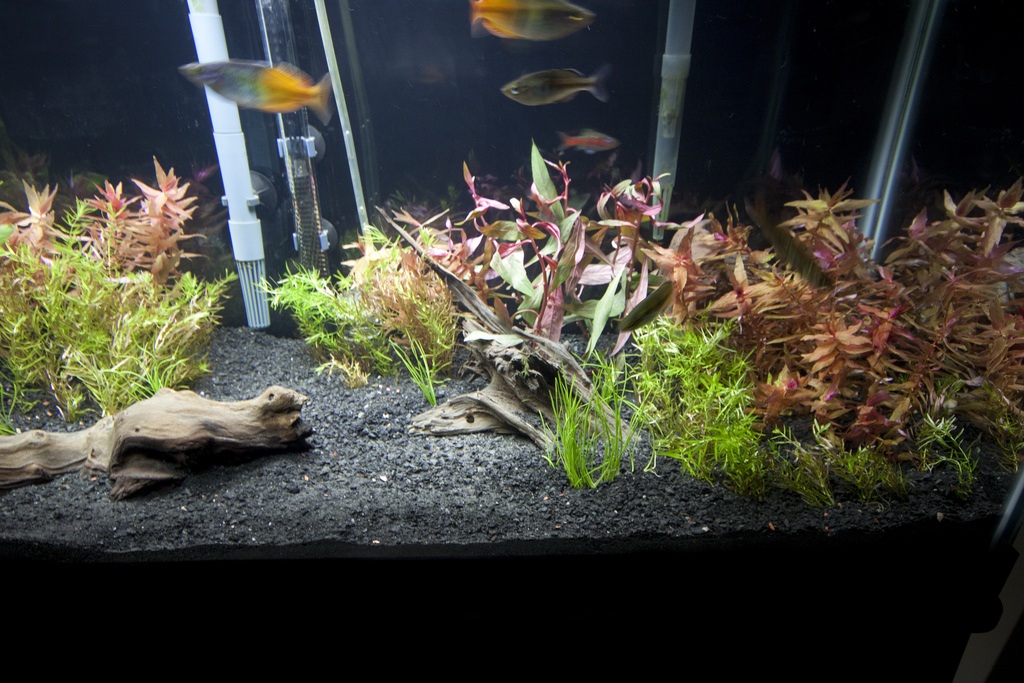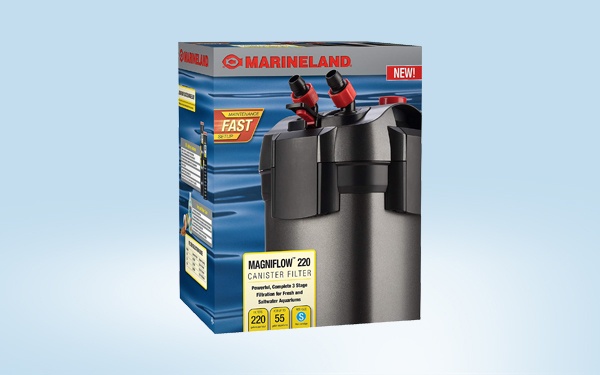If you’re wondering whether you need a canister filter for your aquarium, the answer is definitely YES.
Fish and other aquatic animals and plants are very sensitive to their environment, and need clean water in order to survive and thrive.
When keeping a fresh or saltwater aquarium at home the best way to ensure the water in your tank is unpolluted is by using a filter. Canister filters are generally the most popular and effective.
Here’s our comprehensive guide to buying the best canister filter for your home aquarium…
Contents
How Does a Canister Filter Work?
In a nutshell, canister filters feature a sealed system and usually consist of an inlet tube through which water from the tank is drawn up by a pump into a tube shaped canister where it is forced through a series of filters before being ejected back out again into the tank via an outlet tube.
The direction of water flow depends upon the design of the particular make and model of canister filter.
The majority of canister filters feature integral water pumps housed in the aquarium cover or base, but some designs necessitate an external pump.
If you’re more of a visual learner, here’s a great video on how a canister filter works:
‘Filtration media’ is the term used to describe anything placed in a filter which changes the quality of the water which passes through it.
There are three different choices of filtration media for canister filters, all with their own benefits to optimise the aquarium environment. They can be used singularly or together for super effective filtration:
Filtration Media
Mechanical
Mechanical filtration removes organic debris and particles such as fish waste, uneaten food, plant matter and dust from the tank.
This type of filtration is particularly useful in tanks with species of fish that eat a lot and produce a lot of waste such as goldfish.
Various different forms of filtration media are used in mechanical filters, including foam blocks, filter floss, Fluval prefilter media, and Micron filter pads.
Each type has a porous surfaces with different dimensions of hole specially adapted to effectively trap particles of assorted sizes, so it’s important to choose the filtration media which best corresponds to your aquarium’s needs.
Chemical
To remove toxins and other unwanted chemical nasties from tank water, a canister with chemical filtration is the best choice.
To achieve this, water is pushed through filtration media such as activated carbons, resins, ceramics and other adsorbents that can remove harmful elements including dissolved proteins, copper, nitrates, chlorine, carbohydrates, ammonia and even discolorants.
When using a chemical filter it is important to bear in mind that they can sometimes alter the chemical composition of the water, so this will need to be checked regularly to ensure your aquarium maintains the correct chemical balance.
Biological
To keep your fish and plants safe from the chemical byproducts such as ammonia that they produce in their waste, a biological filter can be very effective.
Biological filters use varying types of bacteria to break down organic waste matter into the slightly less toxic form of nitrites, which are then broken down further by other forms of bacteria into relatively harmless nitrates.
In order to function correctly, biological filtration media requires an oxygen source for the bacteria, ammonia and nitrates in the water as a food source, and the correct temperature for the bacteria to thrive.
Do You Need a Canister Filter?
Canister filters can be used in aquariums of almost any size except the smallest fish bowls.
Most are suitable for both freshwater and marine tanks, although some models will state that they are better suited to one or the other.
The bigger your tank and the more fish you have, the larger and more powerful your canister filter will need to be.
Appropriate aquarium size ranges are normally recommended for each model.

Benefits of Using a Canister Filter
There are multiple benefits to using a canister filter.
Most models have a large filtration media capacity and can house multiple types of filtration media (usually up to three) which means your tank can have chemical, biological and mechanical filtration all neatly packed into one filter.
This also allows you to tailor make your filtration system to your own choosing, so you can find the optimum mix to suit your tank’s specific needs. This is a huge advantage over other types of filter such as HOB (hang on back) filters, which only have limited filtration media capacity and cannot be so effectively customized.
The best canister filters are usually very powerful and effective, but as most are mounted outside of the tank they remain unobtrusive, leaving you to enjoy an unobstructed view of your aquarium environment.
In addition, most models run very quietly and smoothly in sealed housing, so there is no obvious annoying pump noise to disrupt your home environment.
Thanks to high flow rates, filtration with a canister filter is also very fast compared to other types of filter including HOB filters, meaning you get visible results quickly.
In terms of installation and maintenance, canister filters are also winners. Setting up most canister filters is simply a matter of connecting the inlet and outlet tubes and plugging them in, and being externally mounted means that they are super easy to access when troubleshooting, making adjustments, or cleaning.
Canister Filter Maintenance
A good canister filter can last for many years as long as replacement parts are available and the filter is properly maintained.
Blocked filters will have restricted water flow, and will not be functioning efficiently which can have harmful effects on the health of your fish.
How often you will need to perform maintenance will depend on how heavily your tank is stocked and the type of filtration media you are using in the canister.
Tanks with more fish producing more waste will require more regular filter cleaning, and certain types of filtration media will need replacing more often than others, however as a general rule if you clean your canister filter every 1-3 months that should be sufficient.
Another way to tell if your filter needs cleaning is to check the flow rate every week — if it has dropped that probably means it’s time for a cleanup.
Maintenance of a canister filter is fairly simple, so even inexperienced aquarium enthusiasts should be able to perform regular maintenance with very little hassle.
The filter will need to be disconnected from the tank and opened up, and the media baskets separated.
Filtration media can then be cleaned or replaced, and the canister itself cleaned with aquarium water, then all you need to do is to put it all back together again and reinstall it on the tank. You’ll also need to keep the inlet clear of debris when the filter is running.

What to Consider Before Buying A Canister Filter
Not all canister filters are created equally, and there are a number of important factors you should consider before making your investment.
Size
Perhaps the most crucial of these factors is whether the canister filter you want to buy is going to be the appropriate size for your aquarium.
If the filter is too small it won’t be powerful enough to keep the tank water sufficiently clean, and if it’s too large you’ll be spending money unnecessarily on something that is too big for the job.
Tank size recommendations are usually provided for each make and model, so check that this corresponds to your requirements before making your purchase.
Aquarium Type
It’s also important to check that the canister filter is suitable for fresh or saltwater tanks. Most filters work in both environments, but certain models are better adapted to one or the other.
Self Priming or Standard?
A canister filter with a self priming pump has the advantage of automatically getting itself back up and running again in the case of a power outage or any water intake, so if you prefer ease of use or if you are often away from home a self priming filter canister will probably be a better choice than a standard pump.
Flow Rate
The flow rate that you require will depend on the needs of your tank, so ideally you’ll want a canister filter with an easily adjustable flow rate.
Flow rate is usually adjusted using the inlet and outlet valves, and on certain models these can be closed completely so you can perform necessary filter maintenance with the minimum hassle.
Filtration Media
Some canister filters will come complete with filtration media as part of the package to get you started, other models will require you to buy your filtration media separately.
How the media is stacked also changes depending on make and model, so it’s worth checking out different canister filters to see which ones are the most customizable depending on how the media baskets are stacked, and how many different types of filtration media they can hold.
Maintenance Requirements
Filter maintenance is a crucial part of keeping a healthy aquarium, and some canister filters will require less maintenance than others, or may be easier to take apart and clean.
Check to see if your chosen canister filter comes complete with a maintenance kit and accessories to make cleaning and maintenance less of a chore.
The Best Canister Filters of 2017
Fluval External Filter
A best rated canister filter, the Fluval 406 can be used in both marine and freshwater aquariums.
It features powerful filtration that uses multiple stages of biological, chemical and mechanical filtration, and a large media capacity with several sizeable media baskets to ensure maximum efficiency.
Sturdy impellers are specially designed to create nearly no sound when running.
It also boasts an innovative valve system allows you to block water flow without having to disconnect hoses.
This canister filter is available on four different sizes for tanks from 25 to 100 gallons, the largest of which (the 406) has an impressive flow rate of 383 GPH.
Pros
- Self priming
- Very quiet when in operation
- Modifiable flow rates
- Simple to set up
- Easy to clean and maintain
- Comes with filtration media already provided
Cons
- Does not have a spray bar to protect delicate plants and fish
- Hose quality could be better
>>> Read our indepth review of the Fluval 406
SunSun 5-Stage External Canister Filter
This beast of a canister filter has a fast and powerful flow rate of 525 GPH and can handle tanks up to 150 gallons in capacity.
Four roomy media filtration baskets form part of the 5 stage filtration process of the SunSun-China HW-304B, with the fifth stage being a UV sterilizer with on/off switch that zaps nasty bacteria and algae to keep your tank water crystal clear.
>>> Read our full review of the SunSun HW-304B External Canister Filter
Pros
- Mechanical, biological and chemical filtration
- Runs extremely quietly
- Easy to load media baskets
- Large media filtration capacity
- Self priming
Cons
- Does not come with filtration media supplied
>>> Read our indepth review of the SunSun canister filter
Marineland Magniflow Canister
Maybe the best aquarium canister filter is the Marineland Magniflow.
Available in three different sizes for tanks from 30 to 100 gallons, with the largest model having an impressive flow rate of 360GPH.
This high tech canister filter features four bumper sized filtration media baskets complete with carbon, biological, filter-floss pad, and filter foam.
A special flow dish ensures that 100 percent of the tank water is filtered, and a shut off valve and quick release hose connectors make cleaning and maintenance a breeze.
Pros
- Good value for money
- Easy to maintain
- Primes easily
- 3 stage biological, chemical and mechanical filtration
- Quality filtration
- Robust construction
Cons
- Unit is large and takes up a lot of room
- No flow indicator
>>> Read our indepth review of the Marineland Magniflow
Fluval Canister Filter FX4 250
Ideal for keepers of cichlids and other large fish, the mighty 30 Watt Fluval FX4 boasts a flow rate of GPH 450 and can be used for tanks of up to 250 gallon capacity.
This canister filter has 5 stages of water purification for both freshwater and saltwater aquariums.
The removable stack of filtration media baskets are precision crafted to eradicate leakage, making filtration more efficient.
The pump on this canister filter is clever too, as it features electronic Smart Pump Technology to continually monitor the pump, the impellers, and energy efficiency in order to optimise filter performance.
Pros
- Compact size
- Self priming
- Multiple stage filtration
- Easy to install
- Simple to maintain
- Extremely powerful and effective
- Economical
Cons
- Can be a little noisy
>>> Read our indepth review of the Fluval FX4
Fluval Canister Filter, FX6 400
The big brother of the Fluval FX4 Canister Filter, the FX6 benefits from the same multi stage filtration and Smart Pump technology, but boosts performance even further with a monstrous motor giving a flow rate of 563 GPH for large aquariums up to 400 gallons.
Few filters can match the huge capacity, impressive flow rates or ease of starting of the Fluval FX6.
Pros
- Comes with a selection of foam, carbon pad, and biological filtration media
- Ideal for large tanks
- Self priming start system
- Features a clog-free strainer to remove debris
- Easy to maintain
- Features a maintenance reminder function
Cons
- Expensive
>>> Read our full review of the Fluval FX6
Aquatop CF Series Canister Filter
Available in three sizes to suit marine and freshwater tanks from 20 gallons to 175 gallons, the largest model has a GPH of 525, three spacious media baskets, plus a handy UV filter to further eliminate bacteria and algae from the water.
Pros
- Includes activated carbon, bio ball and ceramic ring filtration media
- Inexpensive
- Runs very quietly
- Good for smaller tanks with fewer fish
- Benefits from good mechanical filtration
Cons
- No adjustable flow control
- Not the most robust build quality we’ve seen
>>> Read our review of the Aquatop CF Series canister filter
Hydor Professional External Canister Filter
The Hydor Professional External Canister Filter range includes five different models for tanks from 20 gallons up to 175 gallons.
The midrange 350 model comes equipped with a good selection of filtration media and has a GPH of 280.
Hydor is a highly reputable brand, and for this canister filter they’ve come up with an innovative expandable spray bar which can be customized to suit your aquarium.
This unit also benefits from a large filter volume and an extremely efficient motor.
Pros
- Solid, quality construction
- Simple to set up
- Excellent value for money
- Filters are inexpensive
- Suitable for freshwater and saltwater tanks
- Easy priming system
- Soundproofing means filter makes very little noise
Cons
- Not the simplest canister filter to maintain
>>> Read our Hydor Professional external canister filter review
So now you know everything about buying the best canister filter!
Which is your favorite?









0 thoughts on “The Best Canister Filter For Your Home Aquarium”